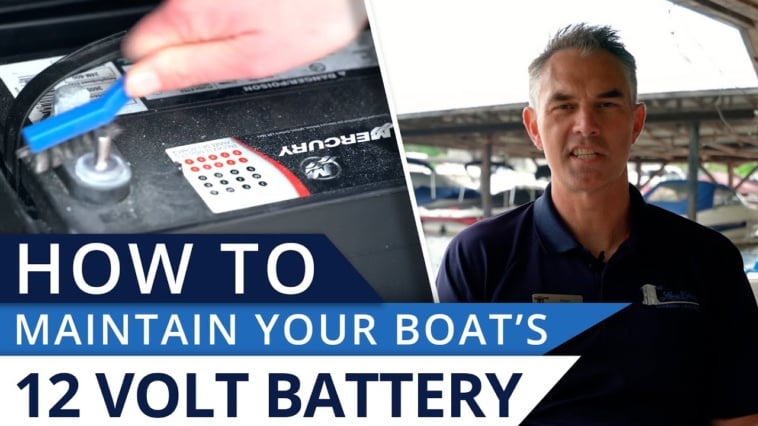So you finally got that boat you’ve been dreaming of, and now you’re wondering how to keep your boat batteries in top-notch condition. Let’s face it, boat batteries are crucial for powering your electronics, starting your engine, and keeping everything running smoothly while you’re out on the water. In this article, we’ll explore the best practices for maintaining and caring for your boat batteries, ensuring that they last longer and perform at their best when you need them the most. From regular inspections to proper charging techniques, we’ll cover it all, so you can set sail with peace of mind.
Regular Inspections
Regular inspections of your boat batteries are essential to ensure their optimal performance and longevity. By taking the time to inspect your batteries frequently, you can catch any potential issues before they become major problems. Here are some key aspects to focus on during your regular inspections:
Check for Corrosion
Corrosion is a common issue that can occur on battery terminals and connections. It is caused by electrochemical reactions between the battery terminals and the surrounding environment. To check for corrosion, carefully examine the battery terminals for any signs of white or green residue. If you notice any corrosion, it is important to address it promptly. Corrosion can hinder the flow of electricity and lead to poor battery performance.
Ensure Proper Connections
In addition to checking for corrosion, it is crucial to ensure that the battery connections are secure. Loose or poorly connected terminals can result in a weak or interrupted electrical connection. This can lead to unreliable battery performance and potential damage to your boat’s electrical system. Make sure that the battery cables are tightly connected to the terminals and that there is no wiggling or movement.
Inspect for Physical Damage
During your regular inspections, take the time to visually inspect your batteries for any signs of physical damage. Look for cracks, leaks, or bulges on the battery case. These can be indicators of internal issues or potential safety hazards. If you notice any physical damage, it is important to address it immediately. Damaged batteries can pose a risk of electrolyte leakage, which not only affects performance but also presents a safety concern.
Cleaning
Proper cleaning of boat batteries is essential to maintain their functionality and prevent the buildup of corrosion and dirt. Regular cleaning can help extend the lifespan of your batteries and ensure that they continue to provide reliable power. Here are some cleaning practices to incorporate into your maintenance routine:
Remove Corrosion
Corrosion on battery terminals can inhibit the flow of electricity and lead to poor battery performance. To remove corrosion, mix baking soda with water to create a paste-like consistency. Gently apply the paste to the corroded areas using a brush or toothbrush. Scrub the terminals and connections thoroughly, ensuring that all residue is removed. Rinse with clean water and dry the terminals before reconnecting them. Regularly removing and preventing corrosion is vital in maintaining optimal battery function.
Clean Battery Terminal
Aside from removing corrosion, it is important to clean the entire terminal surface. Use a mixture of baking soda and water or a battery cleaner solution to thoroughly clean the battery terminals. Apply the cleaning solution to a brush and scrub the terminals and connections until they are free from dirt and grime. Rinse with clean water and dry the terminals before reattaching the cables. By keeping the terminals clean, you can prevent unwanted buildup and ensure a solid electrical connection.
Clean Battery Case
The battery case also requires proper cleaning to prevent dirt and debris from affecting its performance. Start by removing any loose dirt and debris from the battery case using a soft brush or cloth. Then, mix a solution of mild detergent and water and use a cloth or sponge to clean the entire case. Pay special attention to the vent caps and ensure they are free from any obstructions. Rinse with clean water and thoroughly dry the battery case before storing or reinstalling it. By keeping the battery case clean, you can prevent any external factors from compromising the battery’s overall functionality.
Charging
Optimizing the charging process for your boat batteries is crucial for their longevity and overall performance. Proper charging practices can help maintain the battery’s capacity and maximize its lifespan. Here are some essential charging guidelines to follow:
Use the Right Charger
One of the most important factors in charging your boat batteries correctly is using the appropriate charger. Different battery types (such as lead-acid, gel, or AGM) require different charging voltages and processes. Make sure to use a charger that is specifically designed for your battery’s chemistry. Using the wrong charger can lead to overcharging, undercharging, or even damaging the battery. Refer to the battery manufacturer’s instructions or consult with a professional to ensure you have the right charger for your boat batteries.
Follow Manufacturer’s Recommendations
Every battery has specific manufacturer recommendations regarding its charging process and voltage requirements. It is crucial to consult the battery manufacturer’s instructions and follow their guidelines carefully. These instructions provide valuable information on the optimal charging rates, proper use of voltages, and recommended charging times for your specific battery. By following the manufacturer’s recommendations, you can ensure that your batteries are being charged correctly and avoid any unnecessary damage or reduced performance.
Charge at the Right Time
Timing is essential when it comes to charging your boat batteries. It is best to start charging your batteries when they reach 50% to 70% of their discharge level. Charging them too early may lead to reduced battery performance, while waiting until they are fully discharged can lead to sulfation and irreversible damage to the battery. Keeping an eye on the battery’s state of charge and initiating the charging process at the right time ensures optimal battery health and performance.
Storage
Proper storage practices are crucial for maintaining the health and functionality of your boat batteries during periods of non-use. Whether you store your batteries for the winter season or for an extended period, following these storage guidelines can help preserve their performance and extend their lifespan:
Disconnect the Battery
Before storing your boat batteries, it is important to disconnect them from the boat’s electrical system. This prevents any electrical drain or potential short circuits during the storage period. Disconnect the battery cables from the terminals, starting with the negative (-) terminal and then the positive (+) terminal. Loosen the cable clamps and remove them carefully, ensuring that they are not in contact with any metal surfaces. This simple step helps preserve the battery’s charge and prevents any unwanted discharge.
Store in a Cool and Dry Place
When it comes to storing your boat batteries, the environment plays a significant role in their longevity. Choose a storage location that is cool, dry, and free from extreme temperatures. High temperatures can speed up the self-discharge rate of the battery, while extreme cold can harm the battery’s capacity. Consider investing in a battery storage rack or shelf that keeps the batteries off the ground and prevents them from being exposed to moisture. Storing your batteries in an optimal environment helps maintain their charge and overall health.
Keep Battery Charged
While in storage, it is crucial to periodically check and maintain the charge level of your boat batteries. If left unattended for long periods, batteries can self-discharge, which can lead to reduced performance and even sulfation. To prevent this, use a battery maintainer or trickle charger specifically designed for the type of battery you have. This will help keep the battery charged at the optimal level and counteract any self-discharge. Regularly monitoring and maintaining the battery’s charge during storage will ensure that it is ready for use when you need it.
Water Levels
If you have lead-acid boat batteries, checking and maintaining proper water levels is an important aspect of their maintenance. These batteries require regular inspection and, if necessary, the addition of distilled water to prevent damage and ensure optimal performance. Consider the following steps to properly manage the water levels in your batteries:
Check and Maintain Proper Water Levels
Begin by checking the water levels in your lead-acid batteries regularly. Over time, the water in the battery may evaporate, resulting in low water levels. Open each cell cap on the battery and visually inspect the electrolyte levels. The electrolyte should typically cover the battery plates. If you notice that the water level is below the recommended level, it is essential to address it promptly. Be cautious not to overfill the cells, as excessive water can lead to overflow and electrolyte dilution.
Add Distilled Water if Necessary
If the water levels in your lead-acid battery are below the recommended level, add distilled water to each cell to restore the proper electrolyte level. Distilled water is essential because it is free from impurities that can potentially harm the battery’s performance. Use a funnel or a watering system specifically designed for batteries to ensure accurate water level management. Slowly pour water into each cell until the recommended level is reached. Take care not to overfill any cell, as this can cause electrolyte overflow during the charging process.
Monitor Electrolyte Specific Gravity
In addition to maintaining proper water levels, monitoring the electrolyte specific gravity is an effective way to assess the health and charge status of your lead-acid battery. Using a hydrometer, measure the specific gravity of the electrolyte in each cell. Specific gravity values provide insights into the battery’s state of charge and its ability to deliver power. A lower specific gravity indicates a discharged battery, while a higher specific gravity suggests a charged battery. Regularly monitoring specific gravity can help identify any potential issues with the battery’s performance and guide maintenance actions accordingly.
Testing
Periodically testing your boat batteries is essential for assessing their health, diagnosing potential problems, and ensuring their overall performance. Through different testing methods, you can gain valuable insights into the condition of your batteries. Consider incorporating the following battery testing practices into your maintenance routine:
Load Testing
Load testing is a widely used method for evaluating the performance and capacity of boat batteries. This test measures the battery’s ability to deliver a specified load within a given time frame. It simulates the actual usage conditions to determine if the battery is capable of performing adequately. During load testing, a high-resistance load is applied to the battery for a specific duration, and the voltage drop is monitored. If the voltage drops significantly below the desired threshold, it indicates that the battery may need replacement or further attention.
Voltage Testing
Voltage testing is a straightforward and accessible method for assessing the charge status of your boat batteries. Use a voltmeter or multimeter to measure the battery’s voltage. A fully charged lead-acid battery should read around 12.6 volts, while a significantly lower reading indicates a discharged battery. By comparing the measured voltage with the manufacturer’s specifications, you can determine the battery’s current charge state. Regular voltage testing can help monitor the battery’s capacity and detect any abnormalities that may require further investigation.
Specific Gravity Testing
Specific gravity testing is primarily applicable to lead-acid batteries with accessible cells. This test measures the ratio of the density of the electrolyte to the density of water and provides insights into the battery’s state of charge. Using a hydrometer, obtain samples of the electrolyte from each cell and measure their specific gravity. A fully charged battery typically displays a specific gravity value of around 1.27, while a discharged battery shows a lower specific gravity. Regular specific gravity testing allows you to monitor the battery’s charge level and identify any deviations that may indicate battery health issues.
Safety Precautions
Practicing safety precautions when dealing with boat batteries is essential to protect yourself, others, and your boat’s electrical system. Batteries carry electrical charges and can pose certain hazards if mishandled. Before performing any maintenance tasks on your boat batteries, consider the following safety measures:
Wear Protective Gear
When working with boat batteries, it is crucial to wear appropriate personal protective equipment (PPE). This includes safety goggles, gloves, and protective clothing. Safety goggles protect your eyes from corrosive materials or accidental splashes, while gloves shield your hands from chemicals and provide insulation against potential electrical shocks. Wearing protective clothing, such as long sleeves and pants, further minimizes any potential exposure to harmful substances. Prioritizing safety gear ensures that you are adequately protected in case of accidents or chemical contact.
Avoid Smoking or Open Flames
Boat batteries contain flammable gases, such as hydrogen, which can be released during charging or discharging. To prevent any potential ignition or combustion, it is crucial to avoid smoking or exposing the batteries to open flames. Even a small spark can lead to an explosion or fire. Always keep the battery area well-ventilated and ensure that there is no source of ignition nearby. By eliminating the risk of sparks or flames, you can maintain a safe environment when working with your boat batteries.
Properly Dispose of Old Batteries
When it is time to replace your boat batteries, it is essential to dispose of old batteries properly. Boat batteries contain hazardous materials that can harm the environment if not disposed of correctly. Contact your local waste management facility or recycling center for guidance on how to recycle or dispose of your old batteries. Many recycling centers offer battery collection services to ensure their safe disposal. By following proper disposal procedures, you not only protect the environment but also contribute to a sustainable and responsible approach to battery maintenance.
Troubleshooting
Troubleshooting is a critical aspect of maintaining boat batteries. By identifying common battery problems and addressing them promptly, you can prevent further damage and ensure the continued functionality of your batteries. Consider the following troubleshooting steps to tackle battery-related issues:
Identify Common Battery Problems
Understanding common battery problems can help you troubleshoot and address them efficiently. Some common issues include battery sulfation, low electrolyte levels, improper charging, and internal shorts. Sulfation occurs when lead sulfate crystals build up on the battery plates, reducing the battery’s ability to deliver power. Low electrolyte levels can result in reduced battery performance and potential damage. Improper charging practices and internal shorts can also significantly impact the battery’s functionality. By familiarizing yourself with these problems, you can quickly pinpoint the root causes of any battery-related issues you encounter.
Check Charging System
To troubleshoot battery problems effectively, it is crucial to assess the charging system of your boat. Examine the battery charger, alternator, voltage regulator, and all related wiring and connections. Ensure that the charger or alternator is functioning correctly and delivering the appropriate voltage levels. Check the wiring and connections for any signs of damage, corrosion, or loose connections. Faulty charging systems can result in undercharging or overcharging, leading to reduced battery performance or potential damage. Performing regular checks on your boat’s charging system allows you to identify any issues and take the necessary steps to rectify them.
Inspect Wiring and Connections
In addition to the charging system, inspecting the wiring and connections within your boat is crucial for troubleshooting battery-related problems. Faulty or loose wiring, corroded terminals, and poor connections can lead to voltage drops, intermittent power supply, or even electrical shorts. Thoroughly inspect the wiring harness, battery cables, and connection points for any signs of damage or corrosion. Ensure that all connections are tight and secure. Repair or replace any damaged wiring or connections to restore proper electrical flow and prevent further performance issues.
Battery Maintenance Schedule
To ensure consistent and effective care for your boat batteries, it is helpful to establish a battery maintenance schedule. Creating a routine and adhering to it allows you to stay on top of maintenance tasks and ensures that you are giving your batteries the attention they need. Consider the following aspects when developing a battery maintenance schedule:
Create a Maintenance Routine
Start by creating a weekly, monthly, and annual maintenance routine that suits your specific needs and boat usage. A weekly routine can include simple tasks such as visually inspecting the batteries, checking the water levels if applicable, and cleaning the terminals. Monthly maintenance can involve load testing, voltage testing, and more thorough cleaning. Annual maintenance should encompass comprehensive testing, such as specific gravity testing, and potentially replacing older batteries. Establish a schedule that works for you and your boat, considering factors such as usage frequency and environmental conditions.
Follow Manufacturer’s Guidelines
When designing your battery maintenance routine, always refer to the manufacturer’s guidelines and recommendations. Each battery type and brand may have different requirements and specifications. Manufacturers provide valuable information on charging rates, maintenance procedures, and testing intervals specific to their products. By following their guidelines, you can ensure that your maintenance practices align with the battery manufacturer’s specifications, helping to maximize battery performance and longevity.
Document and Track Maintenance Tasks
To effectively manage and track your battery maintenance activities, keep a detailed record of all maintenance tasks performed. This can include dates, specific actions taken, and any observations or test results. Documentation allows you to monitor the history and progress of each battery, identify patterns or trends, and make informed decisions about replacement or further maintenance actions. Additionally, keeping a record of your maintenance activities can be valuable when selling the boat or for warranty purposes. Establishing a systematic approach to documentation ensures that you can effectively manage and track your battery maintenance efforts.
Professional Help
While regular maintenance can address many battery-related issues, there may be instances where seeking professional help is necessary. Consulting with experts and scheduling regular maintenance checks can provide an extra layer of assurance and ensure that your batteries are in optimal condition. Consider the following recommendations for professional assistance:
Consult with Experts
Engaging with professionals who specialize in boat battery maintenance and care can provide valuable insights and guidance. Expert advice can help you navigate specific battery-related challenges and ensure that you are following the best practices for your boat’s batteries. Whether you have questions about battery chemistry, charging processes, or troubleshooting techniques, consulting with experts can provide you with the peace of mind that you are making informed decisions.
Schedule Regular Maintenance Checks
In addition to your own routine maintenance efforts, consider scheduling regular maintenance checks with professionals. These checks can include comprehensive battery testing, professional cleaning, and overall system inspections. Professional maintenance checks allow for a thorough assessment of your batteries, ensuring that no potential issues go unnoticed. Regular visits to professionals who specialize in boat batteries can help catch any problems early on and extend the overall lifespan of your batteries.
Seek Help for Complex Issues
If you encounter complex battery issues or encounter challenges beyond your expertise, it is advisable to seek help from professionals. Some battery problems may require specialized equipment, technical expertise, or a deeper understanding of battery chemistry. Attempting to address complex issues without the necessary knowledge or tools can potentially lead to further damage or ineffective solutions. When in doubt, seek professional help to ensure that the problem is diagnosed accurately and resolved efficiently.
In conclusion, by following these best practices for maintaining and caring for your boat batteries, you can ensure their optimal performance and longevity. Regular inspections, proper cleaning, correct charging procedures, and appropriate storage practices all contribute to the overall health of your batteries. Monitoring water levels, conducting routine tests, and implementing safety precautions further enhance battery maintenance efforts. By establishing a maintenance schedule, following manufacturer’s guidelines, and seeking professional help when necessary, you can effectively care for your boat batteries and ensure that they provide reliable power for your boating adventures.





